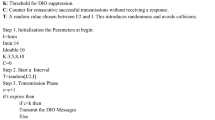Abstract
Many distributed multimedia applications involve data delivery from a source to multiple destinations, the participating nodes forming a multicast group. In the naive solution, separate connections can be established from each source to other group members. However, a tree can be established for each source with the participants as the leaf nodes or just have one tree spanning all the participants. In this paper, we introduce a data forwarding model to support such shared multicast trees over the ATM networks called CRAM (Cell Re-labeling At Merge-points for ATM multicast). Our work allows VC merging in the MPLS architecture and supports recently proposed wide area multicast protocols (like CBT and PIM) in ATM networks.
Similar content being viewed by others
References
G. Armitage, Support for multicast over UNI 3.0/3.1 based ATM Networks, RFC 2022 (1996).
A. Ballardie, J. Crowcroft and P. Francis, Core Based Trees (CBT)-An architecture for scalable inter-domain multicast routing, in: ACM SIGCOMM (September 1993) pp. 85-95.
T. Billhartz, J.B. Cain, E.F. Goudreau, D. Fieg and S. Batsell, Performance and resource cost comparisions for the CBT and PIM multicast Routing Protocols in DIS Environments, in: IEEE INFOCOM (1996).
K.P. Birman, R.V. Renesse and S. Maffeis, Horus: A flexible group communication system, Communications of the ACM 39 (April 1996) 76-83.
R. Callon, P. Doolan, N. Feldman, A. Fredette, G. Swallow and A. Viswanathan, A framework for multiprotocol label switching, Internet Draft draft-ietf-mpls-framework-01, Work in progress (1997).
S. Deering, D. Estrin, D. Farinacci and V. Jacobson, An architecture for wide-area multicast routing, in: ACM SIGCOMM (September 1994).
S. Floyd, V. Jacobson, C. Liu, S. McCanne and L. Zhang, A reliable multicast framework for lightweight sessions and application level framing, IEEE/ACM Transactions on Networking (November 1996).
E. Gauthier, J.Y. Le Boudec and P. Oechslin, SMART: A many-to-many multicast protocol for ATM, IEEE Journal on Selected Areas in Communications 15(3) (April 1997) 458-472.
M. Grossglauser and K.K. Ramakrishnan, SEAM: Scalable and Efficient ATM Multicast, in: IEEE INFOCOM (1997).
S. Komandur and D. Mossé, SPAM: A data forwarding model for multipoint-to-multipoint connection support in ATM networks, in: 6th Internat. Conf. on Computer Communications and Networks, IEEE Computer Society (September 1997).
B.N. Levine and J.J. Garcia-Luna-Aceves, Improving Internet multicast with routing labels, in: IEEE ICNP, Atlanta, GA (October 1997).
T. Tedijanto, J. Drake, R. Rennison, S. Komandur, R. Cherukuri, W.L. Edwards, B. Miller, J.H. Halpern, R. Callon, E.M. Spiegel, Y. Shavit and R. Bhat, Support for Leaf Initiated Join (LIJ) in PNNI, in: ATM Forum Contribution, Chicago, IL (April 1997).
D. Thaler, D. Estrin and D. Meyer, Grand Unified Multicast (GUM): Protocol specification, Internet Draft draft-ietf-idmr-gum-00.txt, Work in progress(July 1997).
L. Wei, Scalable multicast routing: Tree types and protocol dynamics, Ph.D. thesis, Department of Computer Science, University of Southern California (December 1995).
Author information
Authors and Affiliations
Rights and permissions
About this article
Cite this article
Komandur, S., Crowcroft, J. & Mossé, D. CRAM: Cell Re-labeling At Merge-points for ATM multicast. Telecommunication Systems 11, 267–274 (1999). https://doi.org/10.1023/A:1019157620448
Issue Date:
DOI: https://doi.org/10.1023/A:1019157620448




